
Bodianus or the hogfishes is a genus of fish in the family Labridae found in the Atlantic, Indian and Pacific Ocean. These species have many parasites.
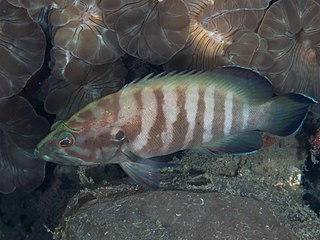
Cephalopholis boenak, the chocolate hind, brownbarred rockcod, brown-banded cod or brown-banded rockcod, is a species of marine ray-finned fish, a grouper from the subfamily Epinephelinae which is in the family Serranidae which also includes the anthias and sea basses. It is associated with reefs over a wide Indo-Pacific distribution. It is an important species for commercial fisheries in some parts of its range.
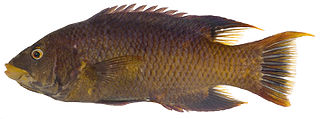
The Spanish hogfish, Bodianus rufus, is a species of wrasse native to the western Atlantic Ocean, where it can be found from North Carolina and Bermuda through the Caribbean and the Gulf of Mexico to southern Brazil. It inhabits coral or rock reefs at depths of 1 to 70 m. While the adults feed on such prey as molluscs, crustaceans, echinoderms, worms, and small fish, the juveniles act as cleaner fishes. This species can reach a length of 40 cm (16 in), though most do not exceed 28 cm (11 in). This species is of minor importance to local commercial fisheries and can be found in the aquarium trade. When Marcus Elieser Bloch named the genus Bodianus he used Bodianus bodianus as the type species of the genus, this is a junior synonym of Bodianus rufus.

Pogonoperca punctata, the spotted soapfish, bearded soapfish or leaflip grouper is a species of marine ray-finned fish, related to the groupers and classified within the subfamily Epinephelinae of the family Serranidae. It is found in the western Indo-Pacific region.

Plectropomus laevis, known commonly as the black-saddled coral grouper, cluespotted coral trout, blacksaddled coral trout, blue-spot trout, Chinese footballer, footballer cod, footballer coral trout, oceanic coral trout or tiger trout, is a species of marine ray-finned fish, a grouper from the subfamily Epinephelinae which is part of the family Serranidae, which also includes the anthias and sea basses. It is found in the Indo-Pacific region.

The barred hogfish is a species of wrasse native to the eastern Atlantic Ocean, where it occurs around the Macaronesian island groups of the Azores, Madeira, the Canary Islands and Cape Verde. This species occurs on rocky reefs at depths of 20 to 200 m. It can reach a length of 43 cm (17 in), though most do not exceed 30 cm (12 in). It is of minor importance to local commercial fisheries. This species was formally described as Labrus scrofa in 1839 by Achille Valenciennes with the type locality given as the Cape Verde Islands.

Bodianus mesothorax, the split-level hogfish, blackbelt hogfish, black-belt hogfish, coral hogfish, eclipse hogfish, eclipse pigfish, mesothorax hogfish or yellow-spotted hogfish, is a species of wrasse native to the western Pacific Ocean and the eastern Indian Ocean.

Bodianus bilunulatus, the tarry hogfish, is a species of wrasse native to the Indian Ocean from the African coast to the western Pacific Ocean to Japan, New Caledonia, and the Philippines.
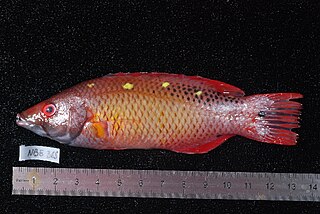
Diana's hogfish, Bodianus diana, is a species of wrasse native to the Indian Ocean from the African coast to the Nicobars and the Cocos-Keeling Islands. Reports of its presence in the western Pacific Ocean are erroneous. It occurs on the seaward side of reefs at depths from 6 to 50 m. It can reach a length of 16.9 cm (6.7 in). This species is of minor importance to local commercial fisheries and is found in the aquarium trade.

The redmouth grouper, also known as the red-flushed rock cod is a species of ray-finned fish, a grouper from the subfamily Epinephelinae which is part of the family Serranidae, which also includes the anthias and sea basses. It has a wide distribution in the Indian and Pacific Oceans. It is considered a game fish.

Apolemichthys trimaculatus, the threespot angelfish or flagfin angelfish, is a demersal marine ray-finned fish, a marine angelfish belonging to the family Pomacanthidae. It has a wide Indo-Pacific distribution.

The Mexican hogfish, Bodianus diplotaenia, is a species of wrasse native to the eastern Pacific Ocean. Adults inhabit rocky or coral areas at depths of 5–75 m. Sometimes, they are also found on sandy bottoms and where marine plants abound. They are solitary or form aggregations of only a few individuals. Mexican hogfish feed on crabs, brittle stars, mollusks, and sea urchins. At night, they gather in cracks and crevices of rocks and caves to sleep. The Mexican hogfish starts life as a female, and later becomes a functional male. Males defend temporary reproductive territories called leks. The sex change may be due to local social conditions, but it may also have a genetic component, since the reversal occurs over a limited size range. They are oviparous, with distinct pairing during breeding.

The chiseltooth wrasse is a species of marine ray-finned fish, a wrasse from the family Labridae. It is native to the Indian Ocean and the western Pacific Ocean. It is an inhabitant of coral reefs and can be found at depths from 3 to 60 m, though rarely deeper than 40 m (130 ft). This species grows to 30 cm (12 in) in total length. It is of minor importance to local commercial fisheries and can be found in the aquarium trade. P. moluccanus is the only known member of its genus.

The lyretail hogfish, also known as the lyretail pigfish, is a species of wrasse from the genus Bodianus. The fish can be found in the Indo-Pacific from the Red Sea to Tuamotu. The adults occur along the seaward edges of reefs and in Micronesia are commonest below 25 metres (82 ft) in depth. They are solitary fish, forming pairs for spawning. The juvelines mimic cleaner fish. The species' diet includes echinoderms, mollusks, crustaceans, and small fish. It grows to a length of 25 centimetres (9.8 in).
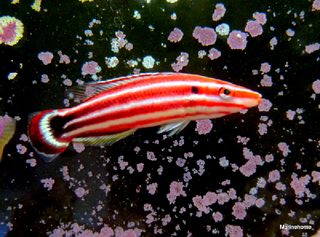
The crescent-tail hogfish, also known as the candy cane hogfish or Pacific redstriped hogfish, is a species of wrasse native to the Pacific Ocean from Sulawesi to the Line Islands. It can be found in groups at depths from 20 to 75 m. This species can reach 8.7 cm (3.4 in) in standard length. Juveniles are white and black. Adults are white with four broad red stripes, suffused with black on caudal peduncle and caudal fin. It can be found in the aquarium trade.

Hologymnosus annulatus, the ring wrasse or ringed slender wrasse, is a species of marine ray-finned fish from the family Labridae, the wrasses, which has a wide Indo-Pacific distribution.
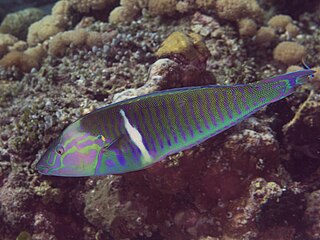
Hologymnosus doliatus, commonly called Pastel ringwrasse , is a marine ray-finned fish belonging to the family Labridae, the wrasses, which is found in the Indo-Pacific area.

Iniistius pavo, the peacock wrasse or blue razorfish, is a species of marine ray-finned fish from the family Labridae, the wrasses, which has a wide Indo-Pacific distribution.

Epinephelus undulosus, the wavy-lined grouper, brown-lined reefcod, mid-water rockcod, mid-water grouper, is a species of marine ray-finned fish, a grouper from the subfamily Epinephelinae which is part of the family Serranidae, which also includes the anthias and sea basses. It has a wide Indo-Pacific distribution. They are produced through aquaculture and commercially fished.

The lemon-striped pygmy hogfish is a species of ray-finned fish from the family Labridae, the wrasses. This species is found on reefs in the Coral Sea off the coast of Queensland and in French Polynesia.























